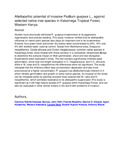| dc.contributor.author | Abonyo, Calvince Rashid Kawawa | |
| dc.contributor.author | Obiri, John | |
| dc.contributor.author | Muyekho, Francis | |
| dc.contributor.author | Omayio, Dennis O. | |
| dc.contributor.author | Humphrey, Agevi | |
| dc.contributor.author | Anastasia, Mwaura | |
| dc.contributor.author | Obiet, Lenard | |
| dc.contributor.author | Kimutai, Donald Kipruto | |
| dc.contributor.author | Sifuna, Anthony | |
| dc.date.accessioned | 2021-06-09T07:10:50Z | |
| dc.date.available | 2021-06-09T07:10:50Z | |
| dc.date.issued | 2016-05 | |
| dc.identifier.uri | https://doi.org/10.9790/3008-1105028086 | |
| dc.identifier.uri | https://www.researchgate.net/publication/309040114_Allellopathic_potential_of_invasive_Psidium_guajava_L_against_selected_native_tree_species_in_Kakamega_Tropical_Forest_Western_Kenya | |
| dc.identifier.uri | http://r-library.mmust.ac.ke/123456789/1663 | |
| dc.description.abstract | Studies have previously attributed P. guajava invasiveness to its aggressive regeneration and profuse seeding. This study, however verified that its allellopathic influence on native plant species also plays an important role in its invasiveness. Extracts from green fresh and brown dry leaves were concentrated to 20%, 10% and 5% with distilled water used as control. Seeds from Markhamia lutea, Diospyros mespiliformis, Cordia africana and Croton megalocarpus; common native species in Kakamega forest, were treated with these extracts in a completely randomised design to determine the extracts impact on their germination, shoot and root elongation. Experiments were replicated 3 times. The two extracts significantly inhibited seed germination, shoot and root length elongation in C. megalocarpus and in C. africana, while in M. lutea and D. mespiliformis the differences were not significant. The study indicated that the inhibitory effect was concentration dependant and was more pronounced at a higher concentration. P. guajava has allellochemicals inherent in it which inhibits germination and growth of some native species. Its invasion of the forest can be mitigated partly by planting resistant trees species like M. lutea and D. mespiliformis, which exhibited resistance to its allelopathic suppression.This study is significant as it will help reduce spread of P. guajava within Kakamega Forest, and can also be replicated in other similar forests in the world with problems of invasion. | en_US |
| dc.language.iso | en | en_US |
| dc.publisher | IOSR Journal of Pharmacy and Biological Sciences | en_US |
| dc.subject | Allellopathic, potential, invasive, Psidium, guajava L., native, tree, species | en_US |
| dc.title | Allellopathic potential of invasive Psidium guajava L., against selected native tree species in Kakamega Tropical Forest, Western Kenya. | en_US |
| dc.type | Article | en_US |

